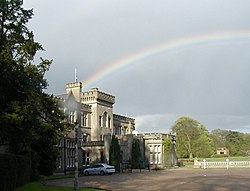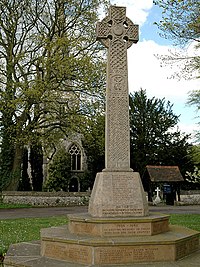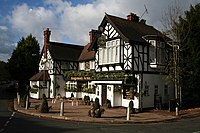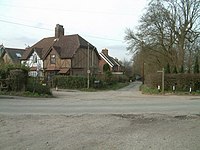Kingswood, Surrey
| Kingswood | |
| Surrey | |
|---|---|
 Kingswood Warren Park | |
| Location | |
| Grid reference: | TQ248559 |
| Location: | 51°17’35"N, 0°12’31"W |
| Data | |
| Population: | 6,891 (2011) |
| Post town: | Tadworth |
| Postcode: | KT20 |
| Dialling code: | 01737 |
| Local Government | |
| Council: | Reigate and Banstead |
| Parliamentary constituency: |
Reigate |
Kingswood is a village on the North Downs in Surrey, which has gradually become attached to its neighbours. It is firmly part of the London commuter belt, The village is to be found just to the east of the A217 separating it from Tadworth and has a railway station. Burgh Heath adjoins it to the north. Kingswood and Burgh Heath together had a recorded population of 6,891 in 2011.
Contents
Churches
The original church of St Andrew was built in 1835, following the Norman style of architecture.[1] It was consecrated in 1836 and became a parish church in 1838. The church, built to accommodate a congregation of 150, soon proved too small for the growing population and in 1848 work began on a larger building on another site.
The present St Andrew's Church was built between 1848 and 1852 at the expense of the then owner of Kingswood Warren, Thomas Alcock, under the supervision of the architect Benjamin Ferrey. It is an exact copy of the 14th century church at Shottesbrooke, Berkshire.[2] In younger years Thomas Alcock had been a frequent house guest of the Vansittart family at Shottesbrooke Park in Berkshire and worshipped at the church there. The old church served as a parish hall until its demolition in the early twentieth century.[2] Cruciform in shape and splendid with beautiful stained glass windows; its tall distinctive steeple is visible for miles around.[3]
Lower Kingswood Church
In Lower Kingswood stands another church, also of the Church of England but in a riot of Greek Orthodoxy, the grandiloquently named Kingswood's Church of Jesus Christ and the Wisdom of God, formerly the Church of St Sophia.[4]. It marks the start of Buckland Road and is a Grade I listed building.[5] it features red brick and stone in various patterns e.g. chequer work, herringbone and basketweave; exotic marble and other stone,[6] nine imported Corinthian capitals from Anatolia, Arts and Crafts movement lectern, pulpit and reading desk, in ebony and holly with mother of pearl inlay, priests' chairs with domed canopies, Byzantine capitals from Constantinople and Ephesus decorate the aisles and west wall.
The name of the church is reflected in those words from 1 Corinthians carved over the west door.[7]
History
Middle Ages
The first specific reference to the land which later charters, parish, hundred and county maps state to be Kingswood is in the Domesday Book, where a passage in the entry for Ewell states that "2 hides and 1 virgate were removed from this manor; they were there before 1066, but reeves lent them to their friends; and 1 woodland pasture and 1 croft" – Ewell's Lords of the manor in 1086 were Osbern of Eu (held of King William) and King William himself.[8]
Henry II granted the manor with Shelwood much further detached, in the Weald, as parcel of the manor of Ewell to Merton Priory,[6] who in 1291 were given licence to inclose the wood of Kingswood as "it was their own soil and without the bounds of the royal hunting forest".[6]
From the time of the Domesday Book, Kingswood, including Lower Kingswood and much of Burgh Heath was a detached part of the parish of Ewell. Between it the Banstead commons which stretched to Reigate forming a buffer particularly for the parish of Walton-on-the-Hill.[8] The wider Copthorne Hundred was a royal hundred: Kingswood by being a liberty was excluded. That hundred around on all sides but the south was worth almost £48 in the 14th century and £136 16s. 4d. in 1636, when it was assessed for ship money.
Burgh Heath however was recorded, appearing as Burgh, held in 1086 by Hugh of Port of Bishop Odo of Bayeux, his overlord; its assets were 5 exemption units (large estates) for which it was taxed on 2.5.[9]
Early Chapel
There was a chapel in the far-removed hamlet of Kingswood which had existed long before the middle of the 15th century; for when the vicarage of Ewell was endowed in 1458, it is mentioned as of long standing. Mention occurs towards the close of the reign of King Edward I.[10] A church ruling stipulated that the vicar of Ewell should not be obliged to minister to the hamlet of Kingswood or to celebrate mass in the chapel there; that when any of the Sacraments of the Church were to be administered to the people of that place, the rectors (Prior and convent of Newark) should provide a priest for the purpose; and in case of the death of any inhabitant of Kingswood and his removal to Ewell for burial, the vicar should meet the body at Provost's Cross, on the south side of Ewell, which had been the custom from ancient time.[11] The subsequent history of this chapel is obscure.
After the Reformation
On the dissolution of the monasteries (1536–8) King Henry VIII seized Kingswood Manor that comprised almost all the land of Kingswood, earlier valued at £14 6s. 8d in 1535, annexing it to the Honour of Hampton Court[6] (its purview).
Queen Elizabeth I bestowed it to the first Lord Howard of Effingham for annual service of one-fortieth of a knight's fee, kept until sold by his grandson, the 2nd Earl of Nottingham.[6] The manor passed through many hands over the ensuing centuries, until bought in the Victorian period by Sir John Hartopp.
In 1632 and from 1669 to 1812 St Mary the Virgin Church, Ewell maintained separate Kingswood books with all the conformist births, deaths and marriages of Kingswood.
The old Brighton Road runs up Reigate Hill through Croydon and Redhill, but was replaced herabouts by a bypass, the A23, which passed through Lower Kingswood and by Upper Kingswood and on into Sutton, which is now the A217, preventing development of the area.[6]
Modernity
Kingswood was until the early 20th century the administrative unit of Kingswood Liberty 1,821 acres, a completely detached part of Ewell parish, bounded on the west and north by Banstead, on the east by Chipstead and Gatton, on the south by Reigate.[6]
Based on the 1841 census, Samuel Lewis writes of Kingswood in 1848 there were 848 inhabitants and, in brief, consisted of 1,800 acres of which 400 were woodland and the remainder almost wholly arable.[10] Kingswood Warren, a grand house, was built about 1850.
Kingswood became in 1899 the terminus of a branch of the South Eastern and Chatham Railway, now the Tattenham Corner branch. Writing in 1911, Malden states: the neighbourhood which used to be singularly sequestered and rural is fast becoming residential, especially since the opening of the railway. But the majority of the new houses are in the part of Banstead included in the ecclesiastical parish of Kingswood, not in the old portion of Ewell.
Kingswood is today characterised by housing which is described as 'arcadian', which implies it is spacious and tree-dominated.[12]
Sport and leisure
Kingswood Golf and Country Club occupies the south of the Kingswood Warren with fine views over Smuggler's Pit Plantation, above the small valley, Hogden Bottom. James Braid, five times Open champion, opened in the 1920s this venue as a 6,954 yard course. Today this offers weddings, catering and conferences "the mature course has undergone extensive re-design and construction.".[13]
Surrey Downs Golf Club occupies an adjacent site, in what was Eyhurst Park, on the Chipstead side, is another 18-hole golf club.[14]
Outside links
| ("Wikimedia Commons" has material about Kingswood, Surrey) |
References
- ↑ Brayley, Edward Wedlake; Britton, J. (1842). A Topographical History of Surrey. p. 273. https://archive.org/details/atopographicalh01roungoog. Retrieved 27 July 2011.
- ↑ 2.0 2.1 "Kingswood, St Andrew: Parish Records, 1836–1990". Surrey History Centre. http://www.exploringsurreyspast.org.uk/GetRecord/SHCOL_6401.
- ↑ St Andrew's Church: A Church Near You]
- ↑ Church of Jesus Christ and the Wisdom of God: VictorianWeb
- ↑ National Heritage List 1029052: Lower Kingswood, Church of Jesus Christ and the Wisdom of God (Grade I listing)
- ↑ 6.0 6.1 6.2 6.3 6.4 6.5 6.6 A History of the County of Surrey - Volume 3 pp 278-284: Parishes: Ewell (Victoria County History)
- ↑ Church of Jesus Christ and the Wisdom of God: A Church Near You
- ↑ 8.0 8.1 Kingswood, Surrey in the Domesday Book
- ↑ Kingswood, Surrey in the Domesday Book
- ↑ 10.0 10.1 Samuel Lewis: A Topographical Dictionary of England pp 683-687
- ↑ Diocese of Winchester Episcopal Registers kept at Wayneflete, i (2) p52
- ↑ Kingswood Warren: Octagon Development
- ↑ Kingswood Golf Club
- ↑ Surrey Downs Golf Club



